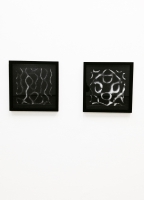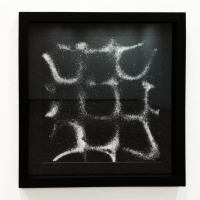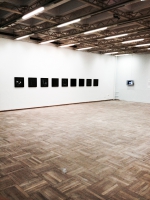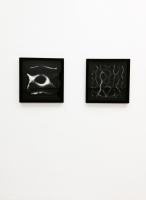2014
FONS
Cymatic Photograms of Chladni Figures
There are places and combinations of cir-cumstances when the weft of the universe becomes visible to the bare eye. The gears of other scales of reality are exposed, from stra- ta that are not immediately accessible to the human senses.
The sound introduced to the aluminum plates spreads like waves of pressure, the deformation surging through the mate- rial at a speed of 20,000 kilometers an hour. The wave bounces off the edges, comes back, and joins its own echoes, creating a spatial pattern of deformations. The process takes place at a speed that exceeds the abilities of our perception.
This phenomenon is described according to strict rules, but, in the majority of cases, turns out to be so fluctuating and complex that it appears chaotic. For certain combinations of dimensions and frequencies, however, a special situation arises, a kind of utter separation, a standing wave. This process can then repeat thousands of times a second, though because the following cycles are identical, it can be perceived in our time frame.
Awave surging through an object is like an earthquake. Its crest can toss up other objects lying on its surface. If we scatter the plate with powder, its particles will be tossed by the crests of the waves in random directions. They are not truly random, however, as everything precisely determines the shapes of the particles, their properties and vector strength. From the point of view of the basic human senses and capabilities, however, it is lottery.
In standing waves the vibrations always occur in the same places. The particles are tossed for so long that they reach areas which are not vibrating, where they come to rest. The result is a stable drawing, a kind of negative in which the concentration of powder corresponds to the nodes. If such a drawing appe- ars as a photographic mask, then the places where the defor- mation has achieved the greatest amplitudes are exposed. The resulting photograph depends on the properties of the pow- der, the exposure time, and the amplitudes of the vibrations. It will always be defined, however, by the pattern of the vibra- tions, the drawing of the waves.
There is something in this experiment that correspondswith the fission of light in a prism, or with observing snowflakes under a microscope. We are looking at reality uncovered. We gain data about the construction of matter, and we simultaneously perceive beauty. Here is something to ponder.
Michał Silski



